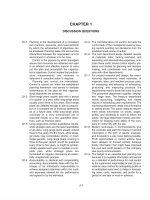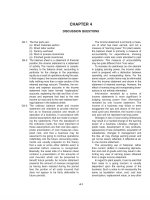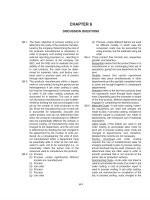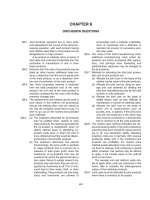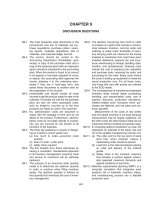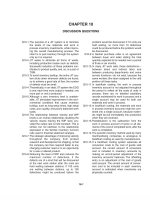Solution manual cost accounting by carter 14e ch13
Bạn đang xem bản rút gọn của tài liệu. Xem và tải ngay bản đầy đủ của tài liệu tại đây (74.74 KB, 31 trang )
CHAPTER 13
DISCUSSION QUESTIONS
Q13-1.
Departmental overhead rates are preferred
to a single rate because they improve the
control of overhead by department heads
responsible for controllable overhead, and
they increase the accuracy of product and
job costing when products or jobs move
through various producing departments.
Q13-2. Departmentalizing factory overhead is an
extension of methods used in establishing a
single rate because (a) an application base
must be selected and estimated; (b) overhead estimates must be made; and (c)
actual overhead must be accumulated and
compared with applied overhead. These
steps are required for each producing
department, whereas with a single rate, only
total factory data are necessary.
Q13-3. The sum of departmental over- or underapplied overhead would be different. Every
direct labor hour would have the same
amount of applied overhead when a plantwide overhead rate is used, assuming that
the application base is direct labor hours.
However, the use of departmental rates
results in different amounts of applied overhead, depending on the labor hours in each
department and the individual departmental
overhead rates. For example, a firm with an
overall rate of $2 would have $20,000 of
applied overhead for 10,000 hours; the
same firm with departmental rates of $1 and
$3 for its two producing departments could
have more or less applied overhead,
depending on the breakdown of labor hours
receiving the $1 and $3 overhead charge.
The total cost of goods sold and total
inventory would also be different, because
departmental rates could cause different
unit costs. Therefore, inventory and cost of
goods sold would be influenced by products
sold or still on hand. This would not be the
case if a blanket rate were used.
Q13-4. A producing department is directly concerned with manufacturing products or
doing work on various jobs. A service
13-1
Q13-5.
Q13-6.
Q13-7.
Q13-8.
department renders service to various
departments and is not directly associated
with manufacturing operations. The nature of
the work done by a department determines
whether it is a service or producing department. Examples of producing departments
are cutting, finishing, machining, mixing, and
refining. Examples of service departments
are maintenance, medical, powerhouse,
purchasing, receiving, and cost accounting.
The kinds of departments established to
control and charge costs depend on (a) similarity of a company’s operations, processes,
and machinery; (b) location of operations,
processes, and machinery; (c) responsibilities for production and costs; (d) relationship
of operations to flow of product; and (e)
number of departments or work centers. The
number of departments established
depends on the emphasis placed on cost
control and on the development of overhead
rates.
Physically different segments of a department or cost pools for different kinds of costs
within a department may be driven by activity bases that are quite different, thus calling
for the use of subdepartments for factory
overhead accumulation, application, and
analysis for each physical segment or cost
pool.
No. A more correct method is the use of the
plant asset records to compute departmental depreciation, property tax, and fire insurance charges, provided the records are
sufficiently detailed for this purpose and the
work involved is not too complex. Such a
method would give proper recognition to the
various depreciation rates used and fire
insurance premiums paid because of varying types of equipment.
Factors involved in selecting the most equitable rate for applying factory overhead
include consideration of the nature of a
department’s operations, the relationship of
overhead elements to operations involved,
13-2
and any clerical difficulties arising through
the use of a particular rate.
Q13-9. The several steps followed in establishing
departmental factory overhead rates are:
(a) Estimating direct overhead of producing
departments and the direct costs of service departments.
(b) Preparing a factory survey for the purpose of distributing indirect departmental costs and service department costs.
(c) Estimating and allocating indirect
departmental costs.
(d) Distributing service department costs.
(e) Computing departmental factory overhead rates.
Q13-10. The questions that must be resolved in
allocating service department costs to benefiting departments include:
(a) Determining which departments are
benefited.
(b) Selecting an allocation base.
(c) Choosing the allocation method, i.e.,
direct, step, or simultaneous.
Q13-11. (a) Direct—No service department costs
are allocated to other service
departments.
(b) Step—Service department costs are
allocated in the order of the departments serving the greatest number of
departments and receiving service from
the smallest number, or in the order of
the largest service department cost allocated to other service departments.
Once a service department’s costs have
been allocated, no costs of other service
departments are allocated to it.
(c) Simultaneous—The full reciprocal interrelationships of benefits among service
departments are considered.
The simultaneous method is the
most accurate for product costing and
for identifying total costs for operating
particular
service
departments.
However, this method is also the most
difficult to compute.
Q13-12. Control of overhead is achieved by comparing actual results with planned or estimated
Chapter 13
results. To make such comparisons, both
types of overhead must be accumulated and
reported in the same manner. Since the computation of overhead rates with required
overhead estimates precedes the incurrence
and accumulation of actual overhead, the
computation procedures determine the
accounting for actual overhead.
Q13-13. Departmental over- or underapplied overhead is determined by comparing actual and
applied overhead.
Q13-14. If a complex product line is produced in a
nondepartmentalized factory or in a single
department of a factory, one approach to
accurate product costing is to use multiple
overhead cost pools and multiple bases
within a single responsibility center.
Q13-15. Nonmanufacturing businesses (such as retail
stores, financial institutions, insurance
companies, educational institutions, and hospitals) should be divided into departments to
budget and control costs. For example, a
retail store might be departmentalized as follows: administration, occupancy, sales promotion and advertising, purchasing, selling,
and delivery. As in manufacturing businesses, departmental costs are prorated to
revenue-producing sales departments by
using a charging or billing rate.
Departmentalization is particularly necessary for hospitals and educational institutions, which must budget their costs on a
departmental basis to control costs and to
charge adequate cost recovering fees.
Q13-16. Government agencies employ large numbers
of people, and as they spend larger and
larger sums of tax money for various services, taxpayers are demanding more efficient
use of that money. Therefore, services should
be rendered at the lowest cost with the greatest efficiency. Governmental activities should
be budgeted and their costs controlled on a
responsibility accounting basis. The efficiency of services should be measured by
using such units of measurement as per
capita, per mile, or per ton.
Chapter 13
13-3
EXERCISES
E13-1
Work in Process .............................................................
Applied Factory Overhead—Department A
(17,000 × $.89*) ...............................................
Applied Factory Overhead—Department B
(18,000 × $1.016**) ..........................................
*$17,800 ÷ 20,000 = $.89
**$20,200 ÷ 20,000 = $1.01
33,310
15,130
18,180
E13-2
Departmental Overhead Columns
General
Factory
Machining
Painting
Assembly Cost Pool
(a) Factory Overhead
Control..................
Accumulated
Depr.—Buildings
(b) Factory Overhead
Control..................
Accumulated
Depr.—Machinery
(c) Factory Overhead
Control..................
Accrued Property
Tax Payable.......
(d) Factory Overhead
Control..................
Accr. Worker’s
Compensation...
(e) Factory Overhead
Control..................
Accrued Power
Payable..............
(f) Factory Overhead
Control...............
Accounts Payable
(g) Factory Overhead
Control...............
Materials ...........
1,500.00
600.00
600.00
300.00
General Ledger
Debit
Credit
3,000.00
3,000.00
6,000.00
2,000.00
1,200.00
400.00
9,600.00
9,600.00
550.00
203.33
170.00
76.67
1,000.00
1,000.00
450.00
180.00
160.00
60.00
850.00
850.00
600.00
60.00
90.00
750.00
750.00
900.00
360.00
360.00
180.00
1,800.00
1,800.00
1,800.00
2,300.00
410.00
4,510.00
4,510.00
13-4
Chapter 13
E13-3
(1)
Budgeted factory overhead..................
Department $1 distribution
(90/300, 210/300) ..................................
Department S2 distribution
(64/80, 16/80) ..........................................
P1
$410,000
P2
$304,000
S1
$100,000
30,000
70,000
(100,000)
40,000
10,000
Budgeted factory overhead..................
Machine hours .......................................
Predetermined rate ...............................
$480,000
÷ 64,000
$7.50
$384,000
Direct labor hours. ................................
÷100,000
Predetermined rate ...............................
3.84
Job 437 overhead cost.
Department P1
(3 × $7.50) .........................................
Department P2
(2 × $3.84) ..........................................
(2)
S2
$50,000
(50,000)
$22.50
7.68
30.18
Plant-wide predetermined factory overhead rate:
$864, 000
= $6.40 per DLH
135, 000 DLH
Job 437 overhead cost (3 × $6.40) .......................................... $19.20
CGA-Canada (adapted). Reprint with permission.
Chapter 13
13-5
E13-4
(1)
$40, 000 + $25, 000 + $361, 956 + $420, 000 $846, 956
= $.83
=
452, 000 + 567, 250
1, 019, 250
(2)
Total
Budgeted factory
overhead ................ $846,956
Distribution of:
Building and
grounds............
Factory
administration..
Total....................... $846,956
Base:
Machine hours
Direct labor
hours................
Rate........................
Machining
Assembly
Building
and
Grounds
$361,956
$420,000
$40,000
18,000
20,000
13,200
$393,156
13,800
$453,800
(40,000)*
Factory
Adminstration
$25,000
2,000
(27,000)**
195,600
$2.01
567,250
$.80
*9/20, 10/20, 1/20 to Machining, Assembly, and Factory Administration, respectively.
**44/90, 46/90 to Machining and Assembly, respectively.
CGA-Canada (adapted). Reprint with permission.
E13-5
Total
Overhead budget.. $1,270,000
Distribution of:
Maintenance
(21/30, 9/30)...
Administration
(15/25, 10/25).
Overhead budget.. $1,270,000
Machine hours......
Overhead rate.......
Cutting
$520,000
Assembly
$400,000
Maintenance
$200,000
140,000
60,000
(200,000)
90,000
$750,000
25,000
$30.00
60,000
$520,000
20,000
$26.00
Administration
$150,000
(150,000)
CGA-Canada (adapted). Reprint with permission.
13-6
Chapter 13
E13-6
Producing
Departments
Budgeted factory
overhead before
distribution of
service departments ..................
Distribution of
service department
costs:
Cafeteria ($10,000
÷ 200 employees
= $50)...................
Product Design
($50,250 ÷ 300
product orders
= $167.50)............
Total
Mixing
Finishing
Service
Departments
Product
Cafeteria
Design
$360,000
$100,000
$200,000
$10,000
3,250
6,500
16,750
$120,000
40,000
$3.00
33,500
$240,000
60,000
$4.00
$360,000
Bases: machine hours
Rates .......................
(10,000)
$50,000
250
(50,250)
CGA-Canada (adapted). Reprint with permission.
E13-7
Budgeted overhead....
Distribution of:
Department S1........
Department S2........
Total factory overhead
Total
$552,750
Producing
Departments
P1
P2
$208,000
$300,000
Service
Departments
S1
S2
$10,000
$34,750
(10,000)*
$552,750
4,500
20,000
$232,500
5,250
15,000
$320,250
*180/400 to P1, 210/400 to P2, 10/400 to S2
**4,000/7,000 to P1, 3,000/7,000 to P2
P1: $232,500 ÷ 4,000 machine hours = $58.125 rate per machine hour
P2: $320,250 ÷ 10,000 direct labor hours = $32.025 rate per direct labor hour
250
(35,000)**
Chapter 13
13-7
E13-7 (Concluded)
(2) Plant-wide rate: $544,750 ÷ 15,000 direct labor hours = $36.317 plant-wide rate per
direct labor hour
(3) Individual jobs may require relatively different amounts of time in each department.
If P1 is machine-intensive and P2 is labor-intensive, then separate departmental
rates would provide a fairer allocation of costs to jobs.
CGA-Canada (adapted). Reprint with permission.
E13-8
(1)
Total
Budgeted factory
overhead...............
$270,000
Allocate Maintenance
($30,000 ÷ 40,000
sq. ft. = $.75 per
sq. ft.) .............
Allocate Personnel
($18,000 ÷ 120
employees = $150
per employee).
$270,000
Divided by machine
hours ..............
Divided by direct labor
hours ..............
Factory overhead rate
Maintenance
Personnel
$30,000
$15,000
$150,000
$75,000
3,000
14,250
12,750
6,000
$170,250
12,000
$99,750
(30,000)
(18,000)
Machining
Assembly
22,700
$7.50
16,625
$6.00
(2) Job No. 3752:
Materials ................................................
Direct labor ...........................................
Factory overhead:
10 machine hours @ $7.50 .............
11 direct labor hours @ $6.00........
Machining
$ 60
24
Assembly
$ 7
99
Total
$ 67
123
66
$172
141
$331
75
$159
CGA-Canada (adapted). Reprint with permission.
13-8
Chapter 13
E13-9
(1)
Equation 1: E = $20,000 + .20F
Equation 2: F = $20,000 + .20E
Equation 3: G = $10,000 + .30E + .10F
Substituting Equation 2 into Equation 1:
E = $20,000 + .20($20,000 + .20E)
E = $20,000 + $4,000 + .04E
.96E = $24,000
E = $25,000
Substituting E = $25,000 into Equation 2:
F = $20,000 + .20($25,000)
F = $25,000
Substituting E = $25,000 and F = $25,000 into Equation 3:
G = $10,000 + .30($25,000) + .10($25,000)
G = $20,000
(2)
Producing
Departments
Department
overhead
before distribution of
service
departments
Distribution
of.:
Department E........
Department F........
Department G .......
Total .....
S
T
$60,000
$ 90,000
Marketing
Department
Service Departments
General
Office
E
$20,000
F
G
$20,000 $10,000
12,500
(25,000)
5,000
7,500
7,500
10,000
5,000
(25,000)
2,500
8,000
6,000
$4,000
$2,000
$75,500
$118,500
$4,000
$2,000
Total
$200,000
(20,000)
$200,000
Actual costs............
$401,000
Total
Actual costs............ $401,000
Distribution of
service department
costs:
F (5/10, 0, 0, 3/10, 2/10)
D (125/325, 60/325,
100/325, 40/325)
C (0, 100%, 0) ......
E (15/40, 25/40)....
E13-11
$30,240
$150,875
10,875
$250,125
(65,000)
20,000
(140,000)
25,000
12,000
140,000
18,125
$(3,400)
1,000
(29,000)
8,000
6,000
Service Departments
D
E
$ 56,000
$ 15,000
$(8,600)
9,000
C
$ 120,000
$(14,600)
2,600
C
$ 12,000
Service Departments
D
E
$ 8,000
$ 2,000
600
400
15,000
Production
Departments
A
B
$100,000
$ 80,000
$20,760
2,040
1,360
1,600
E ....................
3,400
14,600
$51,000
Total
$51,000
Production
Departments
A
B
$15,000
$12,000
1,000
C ....................
D ....................
F ....................
Distribution
of Department
E13-10
(30,000)
F
$ 30,000
F
$ 2,000
$(2,000)
Chapter 13
13-9
13-10
Chapter 13
E13-12
Let:
S1 = $20,000 + .20S2
S2 = $17,600 + .10S1
Substituting: S1 = $20,000 + .20($17,600 + .10S1)
Solving: S1 = $20,000 + $3,520 + .02S1
.98S1 = $23,520
S1 = $24,000
Substituting:
S2 = $17,600 + .10($24,000)
= $17,600 + $2,400
= $20,000
Total P1 overhead =
=
=
=
$94,000 +.40(S1) + .50(S2)
$94,000 +.40($24,000) + .50($20,000)
$94,000 + $9,600 + $10,000
$113,600
E13-13
(1)
The dual predetermined overhead rates are:
$200, 000
= $12.50 per direct labor hour
16, 000 direct labor hours
and
$300, 000
4, 000 machine hours
(2)
= $75 per machine hour
Job #345
Direct material...............................................................
Direct labor (30 × $10)..................................................
Applied overhead:
30 × $12.50 = $375
10 × $75
= $750 ..................................................
Total ...............................................................................
$1,000
300
1,125
2,425
Chapter 13
13-11
E13-14
(1)
The dual predetermined overhead rates are:
$900, 00
= $250 per machine hour
3, 600 machine hours
and
$600, 000
300 tons
(2)
= $2, 000 per ton
Job #103
Parts and materials ......................................................
Applied overhead:
70 × $250 = $17,500
4 × $2,000 = 8,000 ..............................................
Total ...............................................................................
$22,000
25,500
$47,500
13-12
Chapter 13
PROBLEMS
P13-1
(1)
Distribution of Service Department Overhead Using the Direct Method
Producing
Departments
Total
Overhead before
distribution of
service departments ...............
$681,000
Distribution of
Maintenance.........
Gen’l Factory ........
Total factory
overhead............ $681,000
Machine hours......
Direct labor hours.
Overhead rates:
per machine hr...
per direct
labor hr...........
Service
Departments
Smoothing
Maintenance
General
Factory
$175,000
$230,000
$76,000
$200,000
12,667
133,333
63,333
66,667
$321,000
÷ 4,000
$360,000
Grinding
÷ 30,000
$
80.25
*180/1,080 to Grinding, 900/1,080 to Smoothing
**6/9 to Grinding, 3/9 to Smoothing
$
12
(76,000)*
(200,000)**
Chapter 13
13-13
P13-1 (Continued)
(2)
First, the simultaneous equations are solved:
Let: M = $76,000 + (1/10)G
G = $200,000 + (720/1,800)M
Substituting: M
Solving: M
.96M
M
=
=
=
=
$76,000 + .1($200,000 + .40M)
$76,000 + $20,000 + .04M
$96,000
$100,000
Substituting: G = $200,000 + .40($100,000)
= $200,000 + $40,000 = $240,000
Distribution of Service Department Overhead
Using the Simultaneous Method
Producing
Departments
Total
Overhead before
tribution of
service departments .................. $681,000
Distribution of
Maintenance........
Gen’I Factory ......
Total factory
overhead .......... $681,000
Machine hours ...
Direct labor hours
Overhead rates:
per machine hr.
per direct
labor hr..........
Grinding
Smoothing
Service
Departments
MainGeneral
tenance
Factory
$175,000
$230,000
$ 76,000
10,000
144,000
50,000
72,000
(100,000)
24,000
$329,000
÷ 4,000
$352,000
$ 200,000
40,000*
(240,000)**
÷ 30,000
$
82.25
$
11.73
*180/1,800 to Grinding, 900/1,800 to Smoothing, and 720/1,800 to General Factory
**6/10 to Grinding, 3/10 to Smoothing, and 1/10 to Maintenance
13-14
Chapter 13
P13-1 (Concluded)
Distribution of Service Department
Overhead Using the Step Method
Producing
Departments
Total
Overhead before
distribution of
service departments .................. $681,000
Distribution of:
Maintenance......
Gen’I Factory.....
Total factory
overhead............ $681,000
Machine hours ......
Direct labor hours
Overhead rates:
per machine hr. ..
per direct
labor hr. ..........
Service
Departments
MainGeneral
tenance
Factory
Grinding
Smoothing
$175,000
$230,000
$ 76,000
7,600
153,600
38,000
76,800
(76,000)
$336,200
÷ 4,000
$344,800
$ 200,000
30,400*
(230,400)**
÷ 30,000
$
84.05
$
11.49
*180/1,800 to Grinding, 900/1,800 to Smoothing, and 720/1,800 to General Factory
**6/9 to Grinding, 3/9 to Smoothing
Chapter 13
13-15
P13-2
(1)
Predetermined factory
overhead rate.........................
Actual activity base amount...
Applied factory overhead .......
Cutting
Department
Assembly
Department
$ 2.40/MH
× 10,800 MH
$25,920
$ 5.00/DLH
× 12,400 DLH
$62,000
Finishing
Department
$
1.60/DL$
× $ 66,000
$105,600
(2)
Revised factory
overhead rate
Actual overhead for
Projected overhead for
(
first six months ) + ( seco
ond six months )
=
activity base
Projected activity base
(Actual
for first six months ) + ( for second six months )
Cutting Department (machine hours):
$22, 600 + $23, 400 $46, 000
=
= $2.30 per machine ho
our
10, 800 + 9, 200
20, 000
Assembly Department (direct labor hours):
$56, 800 + $57, 500 $114, 300
=
= $4.50 per direct labor hour
12, 400 + 13, 000
25, 400
Finishing Department (direct labor dollars):
$98, 500 + $96, 500 $195, 000
=
= $1.50 per dirrect labor dollar
$66, 000 + $64, 000 $130, 000
13-16
Chapter 13
P13-2 (Concluded)
(3)
The applied overhead accounts should be adjusted by the difference in the factory overhead rates (revised rate less original rate) times the actual activity for
the first six months.
Cutting Department
(($2.30 – $2.40)
×
10,800)
Assembly Department (($4.50 – $5.00)
×
12,400)
Finishing Department
(($1.50 – $1.60)
×
$66,000)
Decrease in applied factory overhead.......................
$ (1,080)
(6,200)
(6,600)
$(13,880)
The applied overhead adjustment is allocated to the inventory accounts and cost
of goods sold on the basis of the unadjusted overhead component in each
account.
Work in Process......................................................
Finished Goods.......................................................
Cost of Goods Sold................................................
$ 12,000
48,000
180,000
$240,000
Debit
Applied Factory Overhead—Cutting ....................
Applied Factory Overhead—Assembly.................
Applied Factory Overhead—Finishing ................
Work in Process Inventory ($13,880 × .05) ..........
Finished Goods ($13,880 × .20) ............................
Cost of Goods Sold ($13,880 × .75) .....................
5%
20
75
100%
Credit
1,080
6,200
6,600
694
2,776
10,410
Chapter 13
13-17
P13-3
Producing Departments
Direct departmental
overhead:
Supervision .............
Indirect labor............
Indirect supplies......
Labor fringe benefits
Equipment
depreciation ........
Property tax,
depreciation of
buildings, etc. ......
Total ..............................
Proration of light
and power.................
Total ..............................
Distribution of service
departments:
General Factory Cost
Pool ......................
Storeroom ................
Repairs and Maintenance ................
Total—producing
departments
Machine hours .............
Overhead rate per
machine hr. ..............
Dept. 14
Service Departments
Storeroom
Repairs
and Maintenance
General
Factory
Cost Pool
Dept. 10
Dept. 12
$20,500
5,400
4,850
6,872
$16,000
6,000
5,600
9,349
$14,000
8,000
5,430
10,145
$7,200
6,133
1,400
640
$8,000
7,200
3,651
760
$24,000
18,000
1,070
2,100
6,000
8,000
10,000
560
1,740
1,100
$43,622
544,949
$47,575
$15,933
$21,351
20,000
$66,270
1,860
$45,482
2,325
$47,274
2,790
$50,365
279
$16,212
1,116
$22,467
930
$67,200
16,800
8,694
20,160
5,670
23,520
2,835
9,024
7,896
11,280
$80,000
800
$81,000
900
$88,000
1,600
$100.00
$90.00
$55.00
2,688
(18,900)**
4,032
1,701
(67,200)*
(28,200)***
*General Factory Cost Pool can be distributed either on the basis of $.80 per square
foot ($67,200 ÷ 84,000 sq. ft.) or on the basis of the following percentages: 25%, 30%,
35%, 4%, and 6% for the first five departments. The percentages are determined by
dividing the square footage in each department by the total square footage.
** Storeroom can be distributed either on the basis of $.07 per requisition ($18,900
÷ 270,000 requisitions) or on the basis of the following percentages: 46%, 30%, 15%,
and 9% for the three producing and one service departments. The percentages are
determined by dividing the number of requisitions in each department by the total
requisitions.
*** Repairs and maintenance can be distributed either on the basis of $1.88 per
maintenance hour ($28,200 ÷ 15,000 hours) or on the basis of percentages: 32%,
28%, and 40% to the three producing departments. The percentages are determined
by dividing the maintenance hours in each department by the total maintenance
hours.
13-18
Chapter 13
P13-4
(1)
Departments
Department costs...............
Allocation of service
department costs:
Repair (1/9, 8/9)...................
Power (7/8, 1/8) ..................
Total overhead cost............
Direct labor hours ..............
Overhead rate per direct
labor hour............................
(2)
Repair
$48,000
Power
$250,000
(48,000)
(250,000)
Molding
$200,000
Assembly
$320,000
5,333
218,750
$424,083
40,000
42,667
31,250
$393,917
160,000
$10.60
$2.46
Algebraic calculations:
R = Repair Department
P = Power Department
R = $48,000 + .20P
P = $250,000 + .10R
Substituting: R = $48,000 + .20($250,000 + .10R)
Solving:
R = $48,000 + $50,000 + .02R
.98R = $98,000
R = $100,000
Substituting: P = $250,000 + .10($100,000)
P = $260,000
Departments
Repair
$48,000
Department costs...............
Allocation of service
department costs:
Repair (1/10, 1/10, 8/10)
(100,000)
Power (2/10, 7/10, 1/10)
52,000
Total overhead cost..........
Direct labor hours ...........
Overhead rate per direct labor hour
(3)
Power
$250,000
Molding
$200,000
Assembly
$320,000
10,000
(260,000)
10,000
182,000
$392,000
40,000
$9.80
80,000
26,000
$426,000
160,000
$2.66
Allocating service department costs to producing departments only ignores any
service rendered by one service department to another, while the simultaneous
method recognizes service departments’ support to one another through the use
of simultaneous equations. The latter method is more complete and should lead
to results of greater use to management.
Chapter 13
13-19
P13-5
(1)
Before distribution .................
Distribution of S1 (4/9, 5/9)....
Distribution of S2 (2/6, 4/6)....
After distribution....................
(2)
Before distribution .................
Distribution of S2 (2/10, 4/10,
4/10)...................................
Distribution of S1 (4/9, 5/9)....
After distribution....................
(3)
Let:
Substituting:
Solving:
Substituting:
Total
P1
P2
S1
S2
$65,000
$23,800
4,000
6,000
$33,800
$ 7,200
(7,200)
$ 9,000
$65,000
$25,000
3,200
3,000
$31,200
Total
P1
P2
S1
S2
$65,000
$25,000
$23,800
$ 7,200
$ 9,000
3,600
6,000
$33,400
3,600
(10,800)
$65,000
1,800
4,800
$31,600
(9,000)
(9,000)
S1 = $7,200 + .40S2
S2 = $9,000 + .10S1
S1 = $7,200 + .40($9,000 + .10S1)
.96S1 = $10,800
S1 = $11,250
S2 = $9,000 + .10($11,250)
S2 = $10,125
Before distribution .................
Distribution of S1 (4/10, 5/10
1/10)...................................
Distribution of S2 (2/10, 4/10,
4/10
After distribution....................
Total
P1
P2
S1
S2
$65,000
$25,000
$23,800
$ 7,200
$ 9,000
4,500
5,625
2,025
$31,525
4,050
$33,475
$65,000
(11,250)
1,125
4,050
(10,125)
13-20
Chapter 13
P13-6
(1)
Let: x = Powerhouse; y = Personnel; z = General Factory
Equation 1:
x = $16,000 + .10y + .20z
x – .10y – .20z = $16,000
Equation 2:
y = $29,500 + .10x + .15z
–.10x + y – .15z = $29,500
Equation 3:
z = $42,000 + .20x + .05y
–.20x – .05y + z = $42,000
Multiply Equation 2 by 10 and add
x – .10y – .20z
–x + 10.00y – 1.50z
9.90y – 1.70z
to Equation 1:
= $ 16,000
= 295,000
= $311,000
Multiply Equation 3 by 5 and add to Equation 1:
x – .10y – .20z = $ 16,000
–x – .25y + 5.00z = 210,000
– .35y + 4.80z = $226,000
Then eliminate y between the resulting equations:
9.90y – 1.70z = $311,000
–.35y + 4.80z = $226,000
(.35)(9.90y) – (.35)(1.70z) = (.35)($311,000)
(9.90)(–.35y) + (9.90)(4.80z) = (9.90)($226,000)
3.465y – .595z
–3.465y + 47.520z
46.925z
z
=
=
=
=
$ 108,850
$2,237,400
$2,346,250
$ 50,000
From the last equation, z = $50,000; putting z = $50,000 in any one of the
equations in which x has been eliminated enables one to find y:
9.90y – 1.70z = $311,000
9.90y – 1.70($50,000) = $311,000
9.90y = $396,000
y = $ 40,000
Then putting y = $40,000 and z = $50,000 in any one of the original
equations enables one to find x:
x – .10y
– .20z
= $16,000
x – .10($40,000) – .20($50,000) = $16,000
x = $30,000
Hence the solution is:
x = $30,000
y = $40,000
z = $50,000
Chapter 13
13-21
P13-6 (Concluded)
(2)
Primary cost.....
Distribution:
Powerhouse.....
Personnel ........
General Factory
Total
$482,500
$482,500
Mixing
$200,000
Refining
$ 90,000
Finishing
$105,000
7,500
14,000
12,500
7,500
12,000
10,000
6,000
8,000
10,000
$234,000
$119,500
$129,000
Powerhouse
$ 16,000
(30,000)
4,000
10,000
Personnel
$ 29,500
General
Factory
$ 42,000
3,000
(40,000)
7,500
6,000
2,000
(50,000)
P13-7
(1)
Annual normal cost center overhead rates:
Department 10:
Cost Center
Cost Center
Department 20:
Cost Center
Cost Center
(2)
Total
Rate
Fixed
Rate
Variable
Rate
10-1 .......................................
10-2 .......................................
$2.40
3.00
$ .90
1.15
$1.50
1.85
20-1 .......................................
20-2 .......................................
$1.15
1.25
$ .32
.30
$ .83
.95
Factory overhead applied to:
Cost
Centers
Department 10:
Cost Center
Cost Center
Department 20:
Cost Center
Cost Center
10-1: 1,220 machine hours × $2.40 =
10-2: 2,000 machine hours × $3.00 =
20-1: 2,250 labor hours × $1.15 =
20-2: 1,650 labor hours × $1.25 =
(3)
Actual factory overhead .....................................
Factory overhead applied...................................
Underapplied (overapplied) ...............................
Depts.
$2,928
6,000
$8,928
$2,587.50
2,062.50
$4,650
Dept. 10
$9,430.00
8,928.00
$ 502.00
Dept. 20
$4,005.00
4,650.00
$ (645.00)
13-22
Chapter 13
P13-8
(1)
The dual predetermined overhead rates are:
$400, 000
= $25 per direct labor hour
$16, 000 direct labor hours
and
$600, 000
$20, 000 machine hours
(2)
= $30 per machine hour
Job #564
Direct material ......................................................................................
Direct labor (30 × $10) .........................................................................
Applied overhead:
30 × $25 = $750
10 × $30 = 300 .........................................................................
Total ......................................................................................................
(3)
1,050
$3,350
Job #632
Direct material ......................................................................................
Direct labor (30 × $10) .........................................................................
Applied overhead:
30 × $25 = $ 750
60 × $30 = 1,800 ......................................................................
Total ......................................................................................................
(4)
$2,000
300
$2,000
300
2,550
$4,850
(a) A single predetermined overhead rate based on direct labor hours would be:
$400, 000 + $600, 000
= $62.50 per direct lab
bor hour
$16, 000 direct labor hours
Chapter 13
13-23
P13-8 (Concluded)
(b)
Job #564
Direct material .................................................................................................
Direct labor (30 × $10)......................................................................................
Applied overhead (30 × $62.50).......................................................................
Total ...................................................................................................................
$2,000
300
1,875
$4,175
(c)
Job #632
Direct material .................................................................................................
Direct labor (30 × $10)......................................................................................
Applied overhead (30 × $62.50).......................................................................
Total ...................................................................................................................
$2,000
300
1,875
$4,175
(5)
The competitive implications of a single overhead rate are that on jobs requiring
much labor and little machine time (e.g., Job #564), MTI will compute its costs at
too high a level and will therefore quote too high a price to the customer. These
jobs will probably be lost to competitors who know their costs better. On jobs
requiring much machine time and little labor (e.g., Job #632), MTI will calculate
its costs at too low a level and will, therefore, quote too low a price. These jobs
will probably be won by MTI because of the low price, but will generate less profit
than expected, or perhaps even a loss.
13-24
Chapter 13
CASES
C13-1
(1)
Empco Inc. is currently using a plant-wide overhead rate that is applied on the
basis of direct labor dollars. In general, a plant-wide manufacturing overhead
rate is acceptable only if a similar relationship between overhead and direct
labor exists in all departments, or the company manufactures products which
receive proportional services from each department.
In most cases, departmental overhead rates are preferable to plant-wide overhead rates because plant-wide overhead rates do not provide:
•
a framework for reviewing overhead costs on a departmental basis, identifying departmental cost overruns, or taking corrective action to improve
departmental cost control.
•
sufficient information about product profitability, thus increasing the difficulties associated with management decision-making.
(2)
Because Empco uses a plant-wide overhead rate applied on the basis of direct
labor dollars, the elimination of direct labor in the Drilling Department through
the introduction of robots may appear to reduce the overhead cost of the Drilling
Department to zero. However, this change will not reduce fixed manufacturing
expenses such as depreciation, plant supervision, etc. In reality, the use of
robots is likely to increase fixed expenses because of increased depreciation
expense. Under Empco’s current method of allocating overhead costs, these
costs will merely be absorbed by the remaining departments.
(3)
(a)
(b)
In order to improve the allocation of overhead costs in the Cutting and
Grinding Departments, Empco should:
•
establish separate overhead accounts and rates for each of these
departments;
•
select an application basis for each of these departments that best
reflects the relationship of the departmental activity to the overhead
costs incurred (e.g., direct labor hours, machine hours, etc.);
•
identify, if possible, fixed and variable overhead costs and establish
fixed and variable overhead rates.
In order to accommodate the automation of the Drilling Department in its
overhead accounting system, Empco should:
•
establish separate overhead accounts and rates for the Drilling
Department;
•
identify, if possible, fixed and variable overhead costs and establish
fixed and variable overhead rates;
•
apply overhead costs to the Drilling Department on the basis of
robot or machine hours.
Chapter 13
13-25
C13-2
(1)
(2)
The company should use departmental overhead rates since the two departments are producing heterogeneous products. The added accuracy is required
for pricing decisions and for better cost control information.
The fixed cost of both service departments should be allocated based on longrange facilities utilization. Variable cost of purchasing would be better allocated
using a cost driver, such as purchase orders, because there is a stronger
explained relationship than by use of volume of materials ordered. Allocation of
variable cleaning cost based on square footage seems reasonable; however, the
variable cost of maintaining equipment should be isolated and charged to
departments based on the cost of services provided.
A fuller consideration of the interactive benefits of departments would be
achieved by use of the step or simultaneous methods, and preferably the simultaneous method. Such consideration is desirable because the service departments provide services to each other.
C13-3
A letter to the president of Summerville Inc:
(1)
Dear Sir:
From a study of the manufacturing operations of Summerville Inc., it is recommended that in distributing its factory overhead, the company use predetermined overhead rates applied as percentages of the direct labor cost. The
company should use predetermined rates based on normal capacity rather than
actual overhead rates because of the wide cyclical fluctuations in its business.
Using actual rates would, due to large fixed overhead costs, make the per unit
overhead cost high in the low production periods and low in the high production
periods. Using predetermined rates, the per unit overhead cost would be level
the year round. For quoting prices and pricing inventories per unit, costs which
are neither inflated nor deflated by the cost of factory facilities are best.
The company should use departmental overhead rates because the rates obviously vary so markedly between departments. An overall rate would not be correct for any department. Summerville Inc.’s overhead is a large part of factory
cost, and any inaccuracy in the per unit cost caused by the use of an overall rate
would be material. If all the products made used all departments proportionately,
an overall rate would result in a substantially accurate total (but not departmental) unit overhead cost. However, in Summerville Inc. the products do not use all
the departments proportionately. Furthermore, use of departmental rates aids in
pinpointing cost control responsibility.
